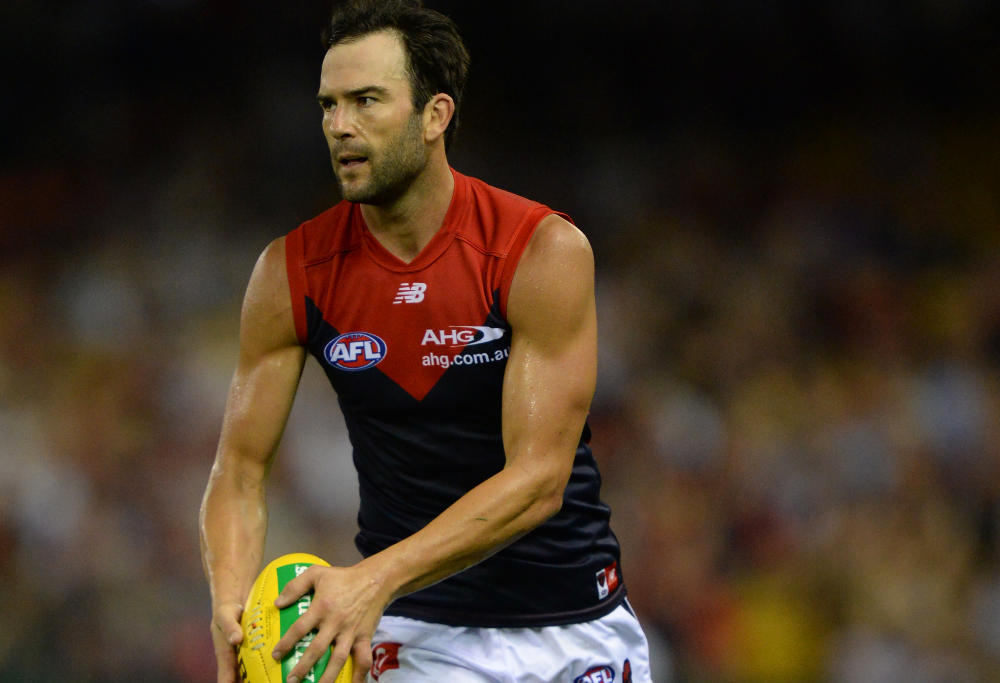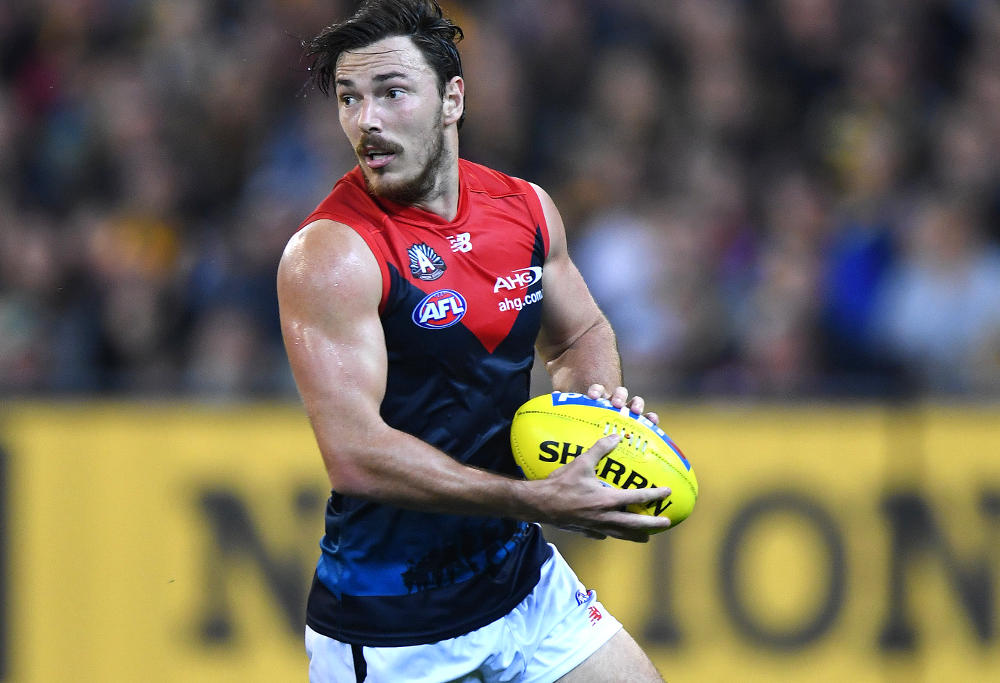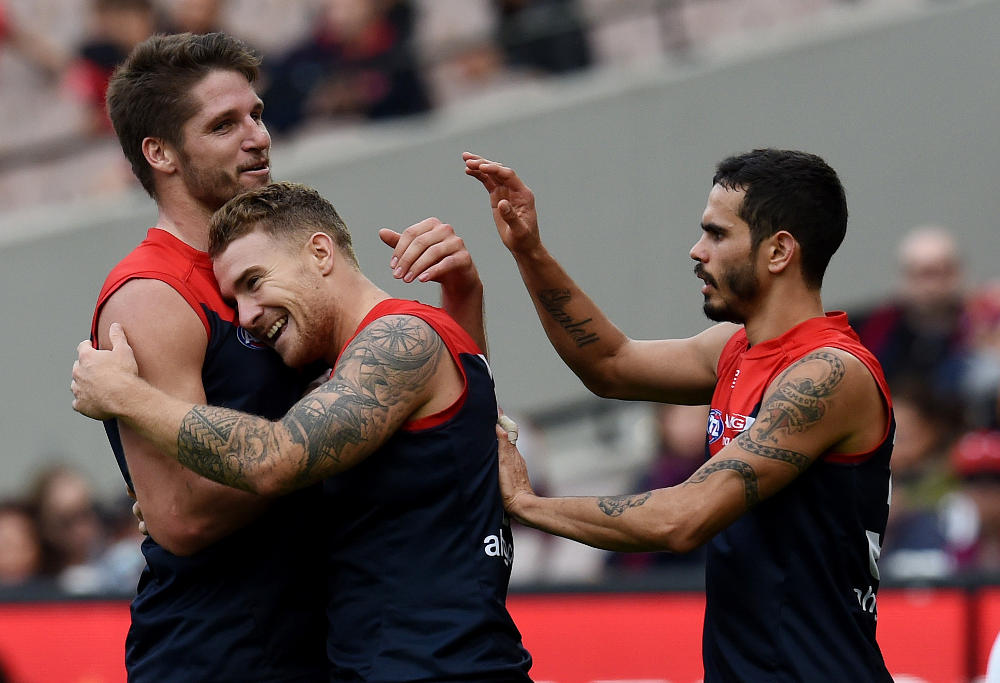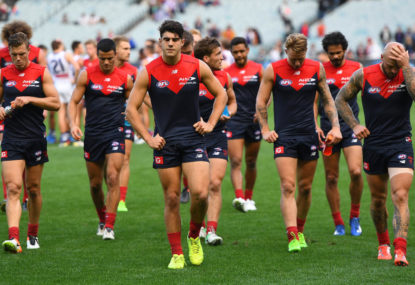Melbourne fans have the worst job in football.
Their team, chock full of interesting and unique pieces, has been tied with their opponent or leading in every final quarter this season. They are 3-4.
It’s brutal. For so long, Melbourne has been the whipping boy of the competition. ‘Things are bad, but at least we’re not as bad as Melbourne!’ That’s churlish, but it isn’t too far from the truth.
Five years ago the Dees were a spent force that was never really a force, a football punchline more stone-faced and serious than a brass statue standing still outside the MCG.
This was the year. It still could be, but it is complicated now. Melbourne has played some of the best football of the season, a raucous blend of outside pace, precision movement and inside dominance that had me thinking this was a GWS Giants-style flex machine in the making.
And then it falls apart. Like it always has for Melbourne. The Demons are a 3-4 with genuine claims to be sitting comfortably in the top four on six wins.
Melbourne have lost both of their close games, and a third by 13 points (against Richmond, in which they conceded the last 14 points of the game). Close losses to the Dockers (two points, the last score a Melbourne behind) and Hawks (three points, the ball in Melbourne’s hands with less than ten seconds to go outside 50) were rub of the green – the kind of losses teams placed just outside the eight come to rue at the end of a 22-game slog.
Close games are the sum total of 120-plus minutes of action and inaction, but for Melbourne there’s a cruelty caked on top that won’t go away no matter how hard the club scrubs.
With some tricky stuff on the way, is it too late for Melbourne? There are reasons to be bullish. They have been the youngest team in all bar one game (against the Tigers in Round 5, when their average age was six days older). Indeed many of the positives we identified in the preseason have come to pass.
Does it all count for naught? Is the game’s middle-class darling once more destined to finish the season a half-finished puzzle?

(Image: AAP Image/Julian Smith)
Zigging in a zagging competition
Melbourne are doing things differently, particularly when they force an opposition turnover or look to exit from their defensive half. In a competition that is putting great stock on fast ball movement, the Dees under coach Simon Goodwin are putting control at the core of the way it does business.
That’s not to say they can’t or don’t go fast. When their kicking creates an opening in an opposition’s zone, the Dees have the pace to take full toll.
That’s often the finishing move. In setting the play Melbourne are all about the marks. They’re the league’s leading exponent of start-stop football, and it’s not really close – although, like the rest of Melbourne’s season, things get complicated.
In wins Melbourne is taking 113 uncontested marks per game. In losses that number drops to 72.8. Their differential of 40.3 is the largest in the competition through seven rounds, ahead of the Saints on 28.2 and four times the average differential in wins and losses.
It’s a similar story on time in possession. Melbourne are leading the league in controlling the ball, with an extra 5.6 minutes of possession per game. Once again, the differential blows out to 9.6 minutes in wins and shrinks to 2.5 minutes in losses. There is a clear desire to control the ball and the pace of play.
Melbourne can move from fast to slow better than any team in the league by hand and foot, through the air and on the ground. Their ability to switch up on the fly suggests they are a well drilled and cohesive team – a gigantic tick for Goodwin in his first seven games as the genuine full-time coach.
They look sideways for a spare man instinctively, and this man isn’t afraid to slow the play down if there isn’t an option forthcoming. From there the whole team gets to work, creating options short and long, back and front and across the width of the ground. Melbourne are big believers in the art of geometry, willing to push the play with incisive, aggressive 45-degree kicks across the ground.
It’s an interesting feature of Melbourne’s game, if only because there is a veritable big-man drought. The Dees have developed a penchant for small ball in the early part of the season, playing with little to no height outside of they key position posts. Melbourne’s midfield is almost exclusively staffed by players under 190 centimetres in height, and their notional ruckman right now, Cameron Pederson, is shorter than Carlton’s Patrick Cripps.

(Image: AAP Image/Mal Fairclough)
Another interesting feature of Melbourne’s personnel is the attacking nature of their defensive posts. There isn’t a scrubber in sight – if you can’t make good, calm decisions and execute long kicks to the advantage of your opponent, you’re not playing in Goodwin’s backline.
There’s nary a full-time stopper to be seen – Tom McDonald and Sam Frost get the key position jobs, but both are very capable with the ball. Oscar McDonald gets the tweener job and helps provide aerial support. Michael Hibberd, who has been excellent, Jayden Hunt and Neville Jetta hoover up the ground balls and provide drive on the deck.
Melbourne seem to like the idea of an extra defender, often foregoing a spare through the middle of the ground and at stoppages to set up effectively behind the play.
Bernie Vince floats around, acting as an on-field coach and interceptor-in-chief. He’s still capable of the occasional ‘Oh Bernie’ moment – as the football world got to see on Anzac Day eve – but for the most part Vince has become a critical part of Goodwin’s scheme.
He’s third at the Dees in intercept possessions with 6.5 per game, behind Michael Hibberd (7.7 in three games) and Sam Frost (7.5). Vince is generating around 150 fewer metres for his team per game despite maintaining his solid output of 25 disposals per game, a sign of the way his role has changed as he plays his 200th game this weekend.
To date their defensive structure is proving mighty effective. The Dees are conceding 10.3 marks inside 50 per game, ranked third in the competition. A quick perusal of opposition scoring profiles suggests when the Dees lose it has been one forward that’s got a hold of them: Tom Hawkins, Jack Riewoldt, Jarryd Roughead all kicked five or more goals in Melbourne losses, while Lachie Neale bizarrely booted four.
At a more macro level, the Dees defence is right around average, ranked ninth with 92 points against for a defensive efficiency rating of +2.8. They’re conceding slightly more points per minute of opposition possession than the AFL average, and their opposition is probing their defensive 50 bang on the AFL average when adjusted for possession. Given Melbourne’s bias for attack, this portion of the ground looks rock solid – even a strength.

(Image: AAP Image/Julian Smith)
A misfiring forward half
We were promised balls-to-the-wall attack in the offseason, and that certainly seems to be the overall objective. Melbourne has stacked its team with runners and gunners and has told them to be careful but deliberate with the ball in hand. But to date it’s yet to translate into a meaningful point of difference in attack.
For their possession dominance, the Dees are scoring just above the league average. Their 98 points per game is a solid mark relative to recent history, but to date six teams have scored more. Melbourne are scoring 1.82 points per minute of possession, a shade below the league average of 1.84. They should be better than this.
The reason? The data suggests their careful ball movement is hurting their collective ability to move into threatening areas of the ground. Melbourne are the 12th-ranked team for inside-50 entries per minute of possession. The Dees break down in the centre of the ground with some regularity, kicking to opposition zones or making little errors that pile up.
It’s where Melbourne’s lack of height comes back to haunt them. Despite their aerial dominance, the Dees have been outmarked in the contested marking stakes by 3.4 per game, ranked 17th behind the skinny bodies of the Brisbane Lions. This doesn’t change in wins versus losses. Contested marks are a relatively small component of the game – there’s only 22 taken a game on average – but it is a telling statistic in context.
Part of this is a personnel play. Melbourne’s forward line is an interesting mix of prodigious talent, but it is far from conventional. Jesse Hogan is an excellent full forward but does not take many marks on the lead. Jack Watts is an excellent half forward flanker but works better up the ground as a set-up man than a finisher inside 50. Jeff Garlett and Jay Kennedy-Harris are solid small forwards but for the most part rely on the work of others to generate opportunities.
On the flanks lurk Christian Petracca and Mitch Hannan, mid-sized forwards who do their best work on the deck. They are missing the mobile marking targets of West Coast, Adelaide, Greater Western Sydney and other settled, well-functioning forward lines. Indeed the Dees still rely on their midfielders to provide a lot of their finishing – Melbourne midfielders, excluding ruckmen, have kicked 34 of the team’s 100 goals, and 66 of 160 scoring shots.
The eye test says Melbourne aren’t as organised or structured as the best teams going forward. Entry kicks are often directed to the goal square regardless of who is waiting, outnumbers be damned.
The Dees want to be a powerful offensive team like the Adelaide Crows. Tellingly the Crows have a slightly worse defence through seven games (after the surprise smacking against North Melbourne), but are scoring almost 30 more points per game than the Dees (an OER of +35.0, a phenomenal mark).
Just squint a little and this group looks special
But if you squint a little, and if you have some faith, this group of players looks like it has remarkable potential forward of centre. With a solid back line in place, the Dees are a tweak or two away from ascending the throne of the league’s powerhouse offences.
It begins with Petracca, a bullocking midfielder with a silky outside player’s football nous and quality disposal. Like a puppy, he’s still capable of running into things and being overzealous at contests, but as he becomes more adept at deciding when to bash and crash, he’s going to be a remarkable and unique talent for the Dees. His play to set up Jordan Lewis for Melbourne’s last goal over the weekend hints at his abundant potential.
He could not have kicked that any better if he tried.
Another unique piece is Clayton Oliver, who is averaging 31 disposals, 14.7 contested possessions, seven tackles and 6.9 clearances as a 19-year-old in his second season in the league.
He appears to have been given a simple message: go and get the ball and handball it to someone. That’s not to say he’s loping around and waiting for the tough stuff – he’s also been a critical part of the Dees linking play, averaging 16.9 uncontested possessions per game (fifth at Melbourne). Remarkably, he’s putting up these numbers playing between 75 and 80 per cent of available minutes.
Oliver is running point, allowing Jack Viney, Nathan Jones and Jordan Lewis some extra space to run out of and around stoppages. The Dees midfield is populated by guys with a bias to the outside as a result, waves of runners able to receive handballs and look for options to get their kick-mark game going.
The midfield is working well in these situations. Over the year Melbourne rank fourth for groundball differential (as a reminder: contested possessions less contested marks less free kicks against), behind Richmond, GWS and Adelaide.
But as the season has progressed it has become clear the Dees are missing the influence of a full-time ruckman. In their stirring Round 1 win against St Kilda the Dees dominated stoppages, winning 44 to 31. In a dominant second and third quarter Melbourne were bursting straight out of stoppages in the centre square and around the ground, overwhelming the St Kilda defence and outscoring them 82 to 25.
Max Gawn (6-8 weeks) and Jake Spencer (4-5 weeks) are propositions in the second half of the year, and so Melbourne will have to make do as they have since the second half of their Anzac Day eve loss to the Tigers. Once they have one or both – as was their preference during the preseason competition – in place, this looks close to a complete team.
Need proof the finished product is almost in place? Melbourne has won 16 quarters of football this year, ranked fourth in the competition behind the two Adelaide sides (20 each) and Greater Western Sydney (18). The only game the Dees have failed to win two or more quarters of football was against Hawthorn.

(Image: AAP Image/Tracey Nearmy)
Entering the torture chamber
But those close losses may come back to haunt Melbourne. The Dees are about to hit the rough patch of their fixture, starting this weekend with an away date with the Adelaide Crows. This looms as the most intriguing match of the round given Adelaide’s previous performance and the status of Melbourne’s season.
Leading into their Round 11 bye the Dees host North Melbourne and journey to Alice Springs for a game against the Gold Coast Suns, who are, just quietly, putting it together over the past few weeks.
After their bye the Dees will play on a double consecutive six-day break: games on Queens Birthday Monday give way to a Sunday trip to Etihad to face the Dogs, a Saturday night game against the Eagles out west and a Friday against the Swans at the MCG.
It is a torturous stretch that the front office will have built their season around. As it stands, the 3-4 record that could be 6-1 make this seven-game, eight-week stretch season defining.
Can the shoulda, coulda, woulda Demons overcome their start and make this tough block work? Right now there are legitimate doubts, albeit the team is in my mind a forward tweak and a returning ruckman away from putting it all together. Even if it doesn’t, the days of feast are much closer than the days of famine; Melbourne’s story is turning.
Right now, almost a third of the way through the season, the Demons loom as one of the season’s biggest what ifs.

































































































